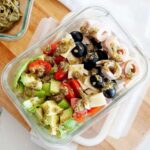Embark on a culinary journey designed to empower those living with diabetes. This guide unveils a world of delicious, low-carb recipes that not only tantalize the taste buds but also actively support blood sugar management. Imagine vibrant breakfast platters bursting with color and texture, satisfying lunches and dinners brimming with fresh vegetables and lean proteins, and convenient snacks that prevent those dreaded afternoon energy crashes. We’ll explore the science behind low-carb eating for diabetes, navigating potential pitfalls and celebrating the incredible health benefits this approach can offer.
From understanding the nuances of glycemic index to mastering low-carb cooking techniques, this resource provides a comprehensive toolkit for creating a personalized meal plan. We’ll delve into specific recipes, offering step-by-step instructions and visual descriptions to guide you through each delicious creation. Prepare to discover a new relationship with food, one that is both flavorful and supportive of your well-being.
Breakfast Recipes

Starting your day with a delicious and diabetic-friendly breakfast is crucial for managing blood sugar levels and maintaining energy throughout the morning. These recipes focus on low-carb, high-protein options to keep you feeling full and satisfied without the blood sugar spikes. Remember to always consult your doctor or a registered dietitian to personalize your meal plan based on your individual needs and health conditions.
Three Low-Carb Breakfast Recipes
This section details three original recipes designed to be both low-carb and suitable for individuals with diabetes. Each recipe provides a balanced combination of protein, healthy fats, and fiber to promote stable blood sugar levels. Portion sizes should be adjusted to meet individual caloric needs.
Recipe 1: Savory Spinach and Feta Omelet
- Whisk 2 large eggs with a splash of milk or cream (optional, for extra richness) and a pinch of salt and pepper.
- Sauté 1 cup of chopped spinach with 1 tablespoon of olive oil until wilted.
- Pour the egg mixture into a lightly oiled non-stick skillet over medium heat.
- Sprinkle 1/4 cup crumbled feta cheese and the sautéed spinach over one half of the omelet.
- Fold the other half of the omelet over the filling.
- Cook for another 2-3 minutes, or until the cheese is melted and the eggs are set.
- Serve immediately. Garnish with fresh herbs, if desired.
Recipe 2: Chia Seed Pudding with Berries and Nuts
- Combine 1/4 cup chia seeds, 1 cup unsweetened almond milk (or other low-carb milk alternative), and a dash of vanilla extract in a jar or container.
- Stir well to ensure the chia seeds are evenly distributed.
- Refrigerate for at least 4 hours, or preferably overnight, to allow the chia seeds to absorb the liquid and form a pudding-like consistency.
- Before serving, top with 1/2 cup mixed berries (strawberries, blueberries, raspberries) and 1 tablespoon of chopped nuts (almonds, walnuts).
Recipe 3: Avocado and Egg Boats
- Halve 2 avocados lengthwise and remove the pits.
- Crack one egg into each avocado half.
- Season with salt, pepper, and a sprinkle of your favorite herbs (such as chives or dill).
- Bake in a preheated oven at 375°F (190°C) for 15-20 minutes, or until the eggs are cooked through.
Creating a Visually Appealing Low-Carb Breakfast Platter
A visually appealing breakfast platter can elevate the dining experience and encourage mindful eating. This platter incorporates varied textures and colors for a delightful sensory experience. Imagine a rustic wooden board, serving as the base, showcasing a vibrant array of colors and textures. The creamy, pale green of the avocado egg boats sits beside the deep green of the spinach omelet, folded neatly to reveal the golden interior and the white flecks of feta. A small bowl of chia seed pudding, its dark brown speckled with the jewel-toned berries, provides a contrasting color and texture. The platter is garnished with a scattering of fresh herbs, adding pops of green and a touch of aromatic freshness. The overall presentation is both simple and elegant, creating a visually enticing and satisfying breakfast.
Five Common Breakfast Mistakes Diabetics Should Avoid
Avoiding certain breakfast choices is crucial for maintaining stable blood sugar levels. These common mistakes can lead to unwanted blood sugar spikes and energy crashes.
- Sugary Cereals and Pastries: These are high in refined carbohydrates, causing rapid blood sugar increases.
- Excessive Fruit Juices: While fruit contains vitamins, juices are often high in sugar and lack fiber, leading to quick sugar absorption.
- Processed Breakfast Meats: Many processed meats are high in sodium and unhealthy fats, potentially negatively impacting overall health.
- White Bread and Toasts: Refined carbohydrates in white bread lead to rapid blood sugar spikes.
- Skipping Breakfast: Skipping breakfast can lead to overeating later in the day and disrupt blood sugar control.
Lunch and Dinner Recipes
Maintaining healthy blood sugar levels is crucial for individuals with diabetes, and carefully planned meals are key. Low-carb lunch and dinner recipes, rich in vegetables, lean protein, and healthy fats, can help regulate blood sugar and promote overall well-being. These recipes focus on satiety and balanced nutrition, minimizing blood sugar spikes.
Five Low-Carb Lunch and Dinner Recipes
The following recipes offer delicious and nutritious options for lunch and dinner, keeping carbohydrate intake low while maximizing flavor and nutritional value. Each recipe emphasizes the incorporation of non-starchy vegetables for added fiber and vitamins.
Mediterranean Salmon with Roasted Asparagus
- Preheat oven to 400°F (200°C). Toss 1 pound asparagus spears with 1 tablespoon olive oil, salt, and pepper.
- Roast asparagus for 12-15 minutes, until tender-crisp. The asparagus will turn a vibrant green and slightly brown at the tips.
- While asparagus roasts, season two 6-ounce salmon fillets with herbs like dill and lemon zest. Drizzle with olive oil.
- Bake salmon alongside asparagus for the last 10-12 minutes of asparagus cooking time, or until salmon is cooked through and flakes easily with a fork. The salmon will be opaque and moist.
- Serve salmon and asparagus together. The vibrant green asparagus contrasts beautifully with the pink salmon.
Chicken and Broccoli Stir-Fry
- Slice 1 pound boneless, skinless chicken breast into bite-sized pieces. The chicken should be a uniform size for even cooking.
- Stir-fry chicken in 1 tablespoon olive oil over medium-high heat until cooked through. The chicken will turn white and opaque.
- Add 2 cups broccoli florets and 1/2 cup sliced bell peppers (any color) to the pan. The vegetables should be brightly colored and firm.
- Stir-fry for 5-7 minutes, until vegetables are tender-crisp. The broccoli should be bright green and slightly softened, not mushy.
- Season with soy sauce (low sodium), ginger, and garlic to taste. The sauce should coat the chicken and vegetables evenly.
Zucchini Noodles with Shrimp and Pesto
- Spiralize 2 medium zucchini into noodles. The zucchini noodles should be thin and even.
- Sauté 1/2 pound shrimp in 1 tablespoon olive oil until pink and cooked through. The shrimp should be firm and opaque.
- Toss zucchini noodles with shrimp and 2 tablespoons pesto. The pesto will add a vibrant green color and creamy texture.
- Season with salt and pepper to taste. The pesto should coat the noodles and shrimp evenly.
- Garnish with grated Parmesan cheese (optional). The cheese will add a salty, sharp flavor.
Ground Beef and Cauliflower Rice Bowl
- Brown 1 pound ground beef in a pan. The beef should be evenly browned and crumbly.
- Add 1 head of cauliflower, riced, to the pan. The cauliflower rice should be finely processed for a rice-like consistency.
- Cook until cauliflower is tender. The cauliflower should be slightly softened but still retain some texture.
- Season with taco seasoning or your favorite spices. The spices will add flavor and aroma.
- Top with your favorite low-carb toppings such as salsa, avocado, and shredded cheese. The toppings will add color, texture, and flavor.
Sheet Pan Sausage and Vegetables
- Preheat oven to 400°F (200°C). The oven should be preheated for even cooking.
- Toss 1 pound Italian sausage (removed from casings) with 1 tablespoon olive oil, 1 cup chopped bell peppers, 1 cup chopped onions, and 1 cup broccoli florets. The vegetables should be chopped into uniform pieces.
- Spread mixture on a baking sheet. The mixture should be spread evenly for even cooking.
- Bake for 20-25 minutes, or until sausage is cooked through and vegetables are tender. The sausage should be fully cooked and the vegetables tender-crisp.
- Season with salt, pepper, and Italian herbs. The herbs will add a fragrant aroma.
Portion Control and Mindful Eating
Maintaining appropriate portion sizes and practicing mindful eating are essential for managing blood sugar levels in individuals with diabetes following a low-carb diet. Mindful eating involves paying attention to hunger and fullness cues, savoring each bite, and eating without distractions. Portion control helps prevent overconsumption, which can lead to blood sugar spikes. Visual cues, such as using smaller plates, can assist in portion control.
Grilling vs. Baking: A Comparison of Cooking Methods
Grilling and baking are popular low-carb cooking methods, each with unique impacts on nutrient retention and overall health. Grilling, using high heat, can lead to some nutrient loss through dripping juices, but it often enhances the flavor of food. Baking, while generally preserving more nutrients, can sometimes result in foods becoming dry if not properly monitored. Both methods can be effective for low-carb cooking, and the choice depends on personal preference and the specific recipe. For example, grilling vegetables may slightly reduce certain water-soluble vitamins, while baking might lead to a slightly higher moisture content in certain dishes.
Mastering a low-carb diet for diabetes is not just about restricting carbohydrates; it’s about embracing a vibrant, healthy lifestyle. By understanding the principles of blood sugar management and exploring the diverse world of low-carb cuisine, you can reclaim control over your health and enjoy delicious, satisfying meals. This guide serves as your culinary compass, empowering you to navigate the journey with confidence and savor every bite. Remember to always consult with your doctor or a registered dietitian before making significant dietary changes.
FAQ Resource
Can I lose weight on a low-carb diabetic diet?
Weight loss is possible on a low-carb diet, but it depends on individual factors and caloric intake. It’s crucial to focus on healthy, whole foods and maintain a balanced approach.
What about fiber intake on a low-carb diet?
Prioritize non-starchy vegetables to ensure adequate fiber intake. Fiber is essential for digestive health and blood sugar regulation, even on a low-carb plan.
Are there any specific foods I should completely avoid?
Highly processed foods, sugary drinks, and refined carbohydrates should generally be avoided. Focus on whole, unprocessed foods.
How often should I check my blood sugar?
Blood sugar monitoring frequency depends on individual needs and should be guided by your doctor or diabetes care team.
What if I experience side effects on a low-carb diet?
Some initial side effects like “keto flu” are possible. Consult your doctor if you experience persistent or concerning symptoms.


